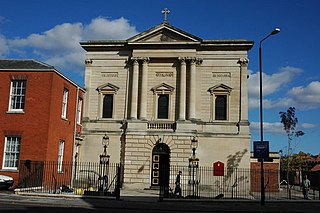
Tamworth is a market town and borough in Staffordshire, England, 14 miles (23 km) north-east of Birmingham and on the West Coast Main Line. The town borders North Warwickshire to the east and north, Lichfield to the north, south-west and west. The M6 Toll runs to the south of the town. It takes its name from the River Tame, which flows through it. The population of Tamworth borough (mid-2019 est.) was 76,696. The wider urban area has a population of 81,964.
Thomas Rickman was an English architect and architectural antiquary who was a major figure in the Gothic Revival. He is particularly remembered for his Attempt to Discriminate the Styles of English Architecture (1817), which established the basic chronological classification and terminology that are still in widespread use for the different styles of English medieval ecclesiastical architecture.
Amington is a suburban village, parish and ward, in Staffordshire, England. Formerly a distinct village, it is now part of the Tamworth borough, with no gap between it and the neighbouring wards of Bolehall, Glascote, Glascote Heath and Stonydelph.

St Laurence's Church, Ludlow, is a Church of England parish church in Ludlow, Shropshire, England. It is a grade I listed building.
Richard Charles Hussey, often referred to as R. C. Hussey, was a British architect. He was in partnership with Thomas Rickman from 1835, whose practice he assumed in 1838 with the latter's failing health; Rickman died on 4 January 1841.
Henry Hutchinson was an English architect who partnered with Thomas Rickman in December 1821 to form the Rickman and Hutchinson architecture practice, in which he stayed until his death in 1831. Hutchinson was born on 16 October 1800 in Ticknall, Derbyshire. He partnered with Rickman after he completed his studies under Rickman. Hutchinson has been described as being an architectural genius.

St. Mary's Church, Selly Oak is a Church of England parish church in Selly Oak, Birmingham, England.

Holy Trinity Church, Coventry, is a parish church of the Church of England in Coventry City Centre, West Midlands, England.

The Church of St Editha is an Anglican parish church and Grade I listed building in Tamworth, Staffordshire, England.

Thorpe Constantine is a small village and civil parish in Staffordshire, England. It lies about 6 miles (10 km) north-east of Tamworth and 6 miles south-west of Measham. The nucleus of the parish is the Thorpe estate.
Bishop Ryder Memorial Church, Birmingham, was a parish church in the Church of England in Birmingham from 1838 to 1960.
William Edward Wadely FRCO was an organist and composer based in England. He achieved the remarkable record of being organist at St John’s Church, Kidderminster, Worcestershire, for 66 years.

St George's Church is a Roman Catholic Parish church in Worcester. It was founded in 1829 and was administered by the Society of Jesus until 1990 when it was handed over to the Archdiocese of Birmingham. It is in the Baroque style, is a Grade II* listed building and was where Edward Elgar was organist from 1885.

St Paul's Church, Dosthill is a Grade II listed parish church in the Church of England in Dosthill, Staffordshire, England.

Amington Parish Church is a Grade II listed parish church in the Church of England in Amington.

St Thomas' Church, Bath Row, is a former Church of England parish church in Birmingham.
St Jude's Church, Birmingham is a former parish church in the Church of England in Birmingham.
St Thomas in the Moors, Balsall Heath is a former Church of England parish church in Balsall Heath, Birmingham.
George Saxby Penfold was a Church of England clergyman, Rector of several parishes and active as a visiting preacher. In 1825 the University of Oxford awarded him the degree of Doctor of Divinity. A pluralist, for much of his life Penfold held the living of more than one benefice at once.
Joseph Theakston was a 19th-century British sculptor mainly working in the Hellenistic style.












